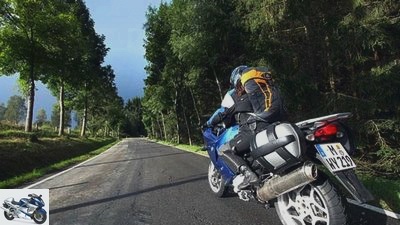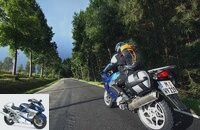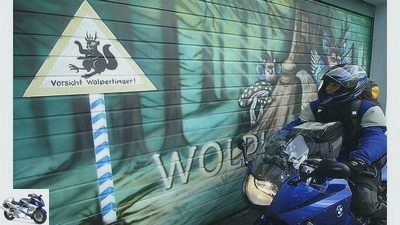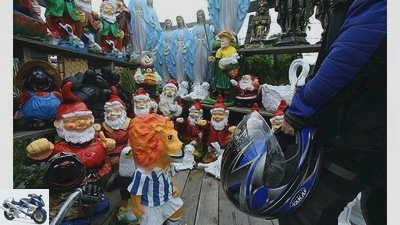Table of contents

Iron ham
to travel
Bavarian Forest, Bohemian Forest
Bavarian Forest, Bohemian Forest
Everything OK
Real forest wilderness is emerging just around the corner in the Bavarian Forest and ?? umava National Parks. Whether by motorcycle, on foot or by canoe ?? Exploring the German-Czech border mountains is an exciting trip. It’s as cool as in Canada or Norway. Shivering, I curve up to Bretterschachten, put on a second fleece sweater at 1120 meters. ?? Cross-country skiing center ?? reads on a sign. Cross-country trails branch off here in winter. Now, in spring, hikers laden with backpacks disappear along winding trails in the conifers. I dash down the well-developed mountain road to the valley, in the corner of my eye the Grober Arber, at 1,456 meters the highest of the Bavarian Forest Mountains. The Arbersee advertises with ?? sun terrace ??, ?? bockwurst rolls ?? and ?? pedal boat rental ??. Nice, but not as tempting as to drive under a clear blue sky over the Great Rain and then to the northwest along the border mountains. At the end of Bayerisch Eisenstein, the road winds in many beautiful loops past the almost 1,300 meter high Osser through the woods. Behind Lam I curve up to Rittsteig and ?? after one last dramatic look back into the valley ?? across the German-Czech border. Leaving Nýrsko and its reservoir behind me, I follow the Uhlava stream towards Hamry. A good choice. The F 800 purrs along a wrinkled lane through the forest. Sometimes bumpy, sometimes curvy. Always through lush green. Behind the mountain hut Hamry, the asphalt ribbon curls two exuberant hairpin bends into the loneliness of the forest, muddles over the mountains for a while, only to spit you out onto a main road.
Sylvia Lischer
05/21/2008
Garden gnomes sit in the colorful front gardens of Schwarzach, behind which the German-Czech border mountains build up. I take my foot off the gas, direct the BMW past idyllic single-family houses with a view of the mysterious, bottle-green mountains. After arriving via the A 3, Deggendorf and Regen, I take the small roads under my wheels, sometimes in narrow, sometimes in long curves, towards the dark spruce forests of the Bavarian Forest and the Bohemian Forest. Bodenmais with its decorated houses and glass factories flies past on the left hand side, which is surrounded by dramatic clouds.
Šumava ridge is getting closer. Here, in the German-Czech border area, moose, lynx and wolves are said to live again. And only a stone’s throw away from garden gnomes and Co. The wilderness, it is said, is returning. Almost like in Canada or Norway.
In my thoughts still just hanging around the beautiful nature, I completely unexpectedly look at a shiny red toadstool. Almighty! The ceramic monster set up on the side of the road is as tall and wide as my front wheel. Behind it, garden gnomes of all sizes cavort, ceramic cows, pigs, deer, eagles, even madonnas, buddhas and pharaohs. I have arrived in Železná Ruda, a picturesque town at the foot of the Great Arber, where colonies of Asian dealers sell cheap products. I slowly direct the BMW past brightly colored glass balls, football tricks, cheap shirts and shoes with a fake Adidas emblem. “Cigarette-perfume-alcohol-24h-non-stop” shops appear. Then it comes together: “Bolero Bar”, “Sandra Night Club”, “Ingo Casino”. And: a nameless night club with the specialty: “whirling bathtub”.
Buy complete article

Bavarian Forest, Bohemian Forest
Everything OK
11 pages) as PDF
€ 2.00
Buy now

Wolpertingers are mythical creatures, a mix of rabbits, foxes and birds. You can find them as a painting at the Barwurz distillery Hieke in Zwiesel.
It gets quieter behind Železná Ruda. The trees move back to the edge of the road. Wood instead of plastic. Green instead of neon pink. Small stalls “Bohemian mushrooms”, “wild berries”, “honey from the beekeeper” blend harmoniously into the landscape. Back in the Bavarian Forest, I let the BMW go into an almost weightless gliding flight and only brake at the sign “Skiwanderzentrum Zwieseler Waldhaus” to spontaneously turn left. Four kilometers through the forest, then it’s the end of the line. But what a. Pretty, wood-clad houses appear, with a sea of pink flowers on the window sills and colorful cottage gardens. I check in at the historic Zwieseler Waldhaus inn and take a few more steps into the forest that starts right behind the garden restaurant. A narrow trail leads over mossy boulders, tree trunks and meter-high ferns. And suddenly they are there: giants of the jungle. Who claw their mighty roots in the ground. Their rough bark has cracks and scars. Which, marked by the centuries, have reached a venerable age. Against the tree shapes in Watzlikhain and Urwald Mittelsteighutte, the standard plants in European forests look like lifeless Mikado sticks stuck into the ground.
Fascinated by the unspoilt nature of the Bavarian Forest National Park, I set off early the next morning to explore the small roads that lead through the national park area on the German and Czech side of the border mountains. The Asian shops were still closed when I drove via Železná Ruda towards the part of the Bohemian Forest that the Czechs call Šumava – that means rustling, roaring forest. But when I study the map at the junction to Srní, the trees appear almost motionless. Birds chirp, crickets chirp. Otherwise it is quiet.
Excitedly, I follow the barely threadbare road that leads through the middle of the Šumava National Park. With a view of the emerald green Bohemian Forest peaks, you pass forest meadows and gnarled solitary trees. Here and there, old military roads branch off – relics from the Cold War era, which are now well-marked cycle routes.
The small road leads across the Bohemian Forest villages of Prášily and Srní to the Vydra, which rages wildly over its stony river bed. With a bit of luck you can see otters between huge granite blocks and fallen trees, which have settled again in the unspoilt landscape. Cyclists are out and about here. And hikers shouldering their rucksacks. The Šumava National Park is an outdoor and discovery area in its purest form.
In Kvilda I come across the main route again, which is barely wider than the secondary route. One look at the map, then I rush over Stražný and the Czech-German border to Freyung and swerve there in the direction of Grafenau. There is plenty of variety: bumpy forest roads in the east and tree avenues sprinkled with cow dung, in the west the finest road surface. Only the mountain panorama is as beautiful here as over there. Near Hohenau I see Grober Rachel and Lusen – at 1,453 and 1,373 meters, the grandees of the Bavarian Forest National Park. But what is it? The forest, still green at the edges, looks like a black and white photograph in the center. Gray tree skeletons soar into the air in ghostly shades of gray.
“It’s growing again,” says National Park Ranger Volker Hartwig, who I ask about the forest shrinkage at the Mauth National Park Information Center. In the mid-1990s, when the worst bark beetle plague in living memory put an end to the emerald-green spruce splendor, the national park administration decided not to intervene. The ranger thinks it’s a good decision. Because what was here before was not a forest, but a forest. And he has to die before real forest wilderness arises.
I explore a few more tiny streets around Mauth and Freyung, which Hartwig, himself a passionate motorcyclist, recommended to me. Then I leave the BMW at the Postwirt inn in Rosenau and take the national park bus to go hiking in the mountains. In Spiegelau I go through the planned route again using the hiking map: Rachelsee, Rachelkapelle, Grober Rachel, Waldschmidthaus. Walking time: four hours, difference in altitude: 700 meters. I want to spend the night in the Waldschmidthaus, which is almost 1400 meters above sea level. Tomorrow I will return to Spiegelau in four hours via the Klingenbrunner Rachelsteig.

Dwarfs are everywhere in the Bavarian Forest and the Bohemian Forest.
When the sun bathes the landscape in golden evening light, I am already high above the Rachelsee and enjoy a limitless panoramic view of the German-Czech sea of peaks. The trail marked “Auerhahn” leads steeply uphill over stones and roots. “Difficult way. Can only be walked on with sturdy shoes! ”Read a sign at the beginning. It passes lush green small spruce trees that grow in a ring around upright dead wood trunks. The dead spruce trees act like a modern radiator, I know from Ranger Volker Hartwig. They protect the young forest from snow and ice. They also release vital nutrients. The new generation of spruce seems to get it. Like organ pipes, they sprout up between the dead wood. Blueberry bushes and mountain ash grow between them. Birch trees, willows and sycamore maples grow here and there – pioneer trees that did not exist here during the times of spruce monoculture. Nobody knows how nature will develop. There is no man-made order, no plan – and yet everything is in the right place. New life emerges from dead wood, colorful butterflies flutter around, the great spotted woodpecker builds a cave, the blossoms make happy bees buzzing.
Rachel Summit, 1452 meters. Exhausted but happy, I sit under the cross on the summit and enjoy the view of Bavaria and Bohemia. The Iron Curtain, which ran through the middle of this landscape, once represented an insurmountable border. Today, Germans and Czechs work together and look together over a national park area of almost a thousand square kilometers. In terms of area, that is as much as Munich plus Frankfurt plus Cologne. If I wanted, I could still wander through the emerging forest wilderness of the border mountains for days and weeks. There are more than 300 kilometers of hiking trails on the German side alone.
But after my two-day trip, I want to ride my motorcycle a bit again. And so for the weekend I ride the BMW from Rosenau via Zwiesel towards the Czech border. The Barwurzerei Hieke (“If you have Barwurz in your bloodstream, you can court like a turkey”) passes by the roadside, the Gasthaus Wurzlsepp in Ludwigsthal. My motorcycle route is now set: Železná Ruda, Horská Kvilda, Vimperk, Horní Vltavice. Then along the Vltava to? Eský Krumlov – a medieval town that has been declared a UNESCO World Heritage Site. Towards the afternoon I fall there on a rustic restaurant terrace with a view of the Vltava and watch how canoes and kayaks whirling fountains whizzing over weirs, sometimes overturning, diving and fighting their way out of the water again.
I want to go on the water too. But rather closer to nature. So I direct the BMW to the Lipno reservoir, stay at a campsite there and book a canoe tour on the young Vltava between Lenora and Nová Pec in the Šumava National Park.
It starts the next morning. The early morning mist is still creeping over the jungle-green hilltops when the canoes at the Soumarsky Most campsite go onto the water and, driven by silent paddles, pass the tent colonies. On the bank, fried eggs sizzle over gas stoves, the zips of sleeping bags buzz, dishes rattle, and plastic bags rustle. Then civilization is over. The boats glide through primeval alluvial forests, which arch their branches like a tunnel over the watercourse, and follow the exuberant bends of the Vltava, which meanders to the south-east in a completely natural way. Here a grass snake that meanders through the crystal clear water. There a gray heron, frightened, leaves his sleeping place. An angler in a good mood raises his hand in greeting, otherwise nobody is to be seen kilometer after kilometer.
Before Nová Pec, the Vltava widens and creates small reed islands. A great egret stands motionless in the water, a great crested grebe family swims past the canoes. If only crocodiles, zebras and hippos are missing, then you would think you were in the endless expanse of the Okawango Delta. Not for long, however, because two bends further you can see the parasols of the “Hostinec U mostu” beach kiosk. Rock arias boom from huge loudspeaker boxes, providing musical accompaniment to the transition from the Czech national river to the Lipno reservoir.
When squeaky canoe lines and air mattresses cross the Vltava River around noon, I am already back on my motorcycle, drive over the Czech-Austrian border near Schoneben and whiz back to the Bavarian Forest National Park via Schwarzenberg and Philippsreut. Feel the thinly marked streets, watch the emerging forest wilderness, enjoy the Canada feeling. And all without jet lag. brilliant!
Info
A trip to the Bavarian Forest and the Bohemian Forest guarantees a special kind of nature experience without neglecting the driving pleasure. A canoe and hiking tour round off the trip!
Info:
Useful information about the Bavarian Forest National Park is available from the association of the national park communities in Neuschonau, phone 08558/91021 (www.national-parkregion.de), and from the national park administration in Grafe-nau, phone 08552/96000 (www.nationalpark- bayerischer-Wald.de). Information about the Bohemian Forest is available from the Czech Tourist Board on 030/2044770 or 089/54885914 (www.czechtourism.com). The Šumava National Park is presented at www.npsumava.cz
Worth seeing
A nice selection of historical Czech motorcycles can be found in the Motorcycle Museum in Železná Ruda (phone 00420/377/982570). The extensive castle complex of? eský Krumlov is the second largest castle in the country after the Prague Castle and can be visited daily (except Mondays) from April to October (phone 00420/380/704720, www.castle.ckrumlov.cz). In the Český Krumlov Mill, in addition to a good restaurant, there is another museum of historical motorcycles (phone 00420/380/712838, www.krumlovskymlyn.cz). The visitor center Hans-Eisenmann-Haus (Bohmstrabe 35, 94556 Neuschonau) offers an outdoor animal enclosure with bears, wolves and lynxes that is well worth seeing.
Stay
Idyllically located on the edge of the forest (with a beautiful garden restaurant): the historic inn and hotel Zwieseler Waldhaus in 94227 Zwieselerwaldhaus, phone 09925/902020 (www.zwieselerwaldhaus.de). The boss drives a motorcycle and has a lot of written tour tips in stock. Gasthof Postwirt, 94481 Grafenau, phone 08552/96450 (www.hotel-postwirt.de). There are written tour tips for motorcyclists on request. At an altitude of 1375 meters, you can spend the night in a double room, single room or in a bed dorm in the Waldschmidthaus and enjoy fantastic meals. Reservation is strongly recommended. Telephone 0172/7850362 or 0171/5234051 (www.waldschmidt-haus.eu). If you stay at the Postwirt, you can leave your motorcycle there, take the Igelbus to Glassung and hike from there to the Waldschmidthaus. There are numerous campsites on the north-western bank of the Lipno reservoir.
hike
In the Bavarian Forest National Park alone there are over 300 kilometers of very well signposted hiking trails. The national park rangers are available to answer any questions on the way. A must is the hike on the Seelensteig or from Gfung to the 1453 meter high Rachel summit.
canoeing
The Vltava is not a whitewater area. Canoe, kayak and rafting tours can therefore also be mastered by beginners. Rental boats and organized tours of various lengths are offered by Inge Tour in ViššyBrod, phone 00420/380/746139, www.ingetour.cz. “On gentle waters” is the name of an exciting canoe tour that begins south of the village of Lenora and ends in Nová Pec. It takes the traveler to a Europe like it was 50 or more years ago. Small bridges cross the river twice, otherwise you are surrounded by the almost untouched nature of the Šumava National Park. Weirs are as strange on this section of the river as road noise or bank barriers. The tour over 26 kilometers of river takes about 5.5 hours. Those who get directly into Lenora gain an additional 1.5 hours.
Literature / maps
Both the Bavarian and the Bohemian side of the border mountain tour are very well represented by the general map of the Czech Republic, sheet 1 “West Bohemia, Central Bohemia” on a scale of 1: 200000. Price: 6.50 euros. Background information and practical tips can be found in the travel volume “Sudbohmen – Bohmerwald”, Michael Muller Verlag, 15.90 euros. “Wild forest nature – The Bavarian Forest National Park on the way to the forest wilderness”, EUR 4.90, can be obtained from the Bavarian Forest National Park shop, phone 08558/973404 (www.nationalpark-laden.de). The travel and hiking guide “Around the Bavarian Forest National Park” by P. Thimm, published by Ohetaler Verlag for 7.95 euros, is especially recommended for the national park. For the Bohemian side, Freytag Berndt publishes the hiking, cycling and trail map WKCZ 3, “Bohmerwald – Mitte, Dreieckmark” and the WKCZ 4, “Bohemian Forest – East, Lipno”, scale 1: 50,000, price 6 each , 90 euros. For the Bavarian side, we recommend the Fritsch hiking maps on a scale of 1: 35000 for 5.85 euros each with the numbers 59 (national park southern part) and 120 (national park northern part).
Travel time: four days. Distance covered: 800 kilometers
Related articles
-
MOTORCYCLE tour tip: Bavarian Forest
Iron ham 19th pictures Iron ham 1/19 Bavarian Forest, Bohemian Forest and Muhlviertel are a varied touring area in Germany. Iron ham 2/19 Tour 1:…
-
In the Bavarian Forest by motorcycle
Seitz to travel In the Bavarian Forest by motorcycle Motorcycling in the Bavarian Forest Especially good in winter Riding a motorcycle in the dark…
-
Winter trip to the Bavarian Forest
Iron ham 12th pictures Iron ham 1/12 Where piles of motorbikes park at the Arberseehaus Biketreff in summer, piles of icicles await in winter. Iron ham…
-
On the way: Elephant meeting in the Bavarian Forest
Iron ham to travel On the way: Elephant meeting in the Bavarian Forest On the way: Elephant meeting Crazy winter get-together in the Bavarian Forest…
-
Tour tip: Motorcycling in the Black Forest
Iron ham 17th pictures Iron ham 1/17 Motorbike tour in the Black Forest: It cannot be emphasized enough: The attraction of riding a roller coaster on a…
-
Oil trap in the Bavarian Forest
State Building Authority Passau / Police Grafenau counselor traffic & business Oil trap in the Bavarian Forest Oil trap in the Bavarian Forest Third time…
-
The 23rd elephant meeting in the Bavarian Forest
Schumann 22nd pictures Schumann 1/22 Elephant meeting 2011 Schumann 2/22 Celebrate and camp at six degrees below freezing. Schumann 3/22 Snow chains are…
-
On the go: 1000 curves in the Black Forest
Jahn 18th pictures Jahn 1/18 The curve hunting starts early in the morning. The goal is to know at the end of the day how many corners you can take. Jahn…
-
MOTORCYCLE tour tip – Central Black Forest tour
Tour tips Exclusive motorcycle tours for children to follow Presented by Dirk Schafer to travel MOTORCYCLE tour tip – Central Black Forest tour…
-
MOTORCYCLE tour tip – Black Forest south circuit
Tour tips Exclusive motorcycle tours for children to follow Presented by Dirk Schafer to travel MOTORCYCLE tour tip – Black Forest south circuit…